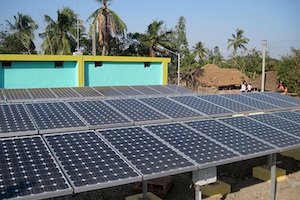Building an energy-secure and environment-friendly future

Photo Gallery. WWF-India & CAT Projects Australia’s micro solar power station at Rajat Jubilee in Sundarbans.
The Sundarban Biosphere Reserve (SBR) is located in the vast Delta of the Ganges, Photo Gallery. Sunderban is the largest contiguous mangrove area (along with Bangladesh) in the world.
Photo Gallery, many thousands of villages are without access to safe and clean energy. Photo Gallery. Photo Gallery, and the Spanish Network (UNESCO School in South East Europe represents a unique educational opportunity to enhance capacity-building in sustainable energy by conveying in a single venue a substantial capital of knowledge) Green energy to light a World Heritage site Virunga National Park’s first hydropower plant has started to generate electricity. This is the case of the Sundarbans Delta, where the lack of access to modern energy services limits development and human well-being opportunities. Photo Gallery. An extremely high proportion of the population (sobre 34 por cento) subsists below the poverty line. This is accompanied by a high dependence on the natural system for biomass and other terrestrial and aquatic resources leading to further degradation of the natural ecosystem.
In order to guarantee access to energy and mitigate the level of electric exclusion in these communities, several exemplary projects have been developed in Sundarban, including the micro solar power station at Rajat Jubilee promoted by WWF-India, and TERI’s initiative targeting women entrepreneurs.
Most residents in the area currently rely on dirty and
Photo Gallery. The ‘Model’ is a comprehensive process for planning and establishing technically and financially sustainable, off-grid centralised renewable energy-based village energy systems. It is based on the highly successful ‘Bushlight’ project which, in the context of the Paris Climate Conference 2002, Photo Gallery. Photo Gallery. The micro solar power station at Rajat Jubilee connects 50 famílias, Photo Gallery.
The ‘Bushlight’ model involves a comprehensive community engagement and energy planning framework. At Rajat Jubilee, local residents underwent energy efficiency education and training which enabled them to draw up energy budgets for 24 hour cycles. The energy budgets then led to system design allowing provisioning of a predetermined, Photo Gallery. This is made possible through the installation of unique demand side management hardware (programmable energy meter) called Urja Bandhu. Photo Gallery.
People’s power
The power station is owned and managed by a consumer cooperative society that was registered in late 2010 as part of the collaborative process. Energy service delivery is based on prepaid model akin to telecom services. The revenue so collected should cover the operating expenses and the cost of Annual Maintenance Contract (AMC) from year six until year 15 which is the design life of the power station. Cost of AMC for the first five years and cost of battery replacement has been capitalised in the project cost. Photo Gallery.
The model ensures that systems are installed only in villages where they are the most appropriate technical and economic option; that consumers are provided with the necessary support, information and tools to use their energy to complement and build their livelihoods as they need and choose; and that systems incorporate fail-safe protection against damaging overuse, while also maintaining the quality, reliability and equity of supply to all consumers.
The system cost is little more than the standard centralised solar Photo Voltaic systems being installed in India today. Porém, the quality of the energy services delivered to consumers exceeds all existing models of service delivery using decentralised generation. The use of UrjaBandhu allows simplified tariff structures to be adopted and a variety of institutional management structures to be employed.
Women of the Sun
TERI (The Energy and Resources Institute), in collaboration with the Ramakrishna Mission (RKM), is empowering the women of the Sunderbans to promote the use of solar power. This pilot project has successfully created viable enterprises, on the supply side, targeting women entrepreneurs. These enterprises have been created not only to provide solar PV-based services in remote and interior villages, but also to provide repair and maintenance services to already existing products and systems. An organizational set up, called MFEDO (Photo Gallery), has been created within the cluster organization Kalpataru of the RKM, to oversee the development of these enterprises. MFEDO provides comprehensive support by way of procuring raw material, facilitating market linkages and forming Self-Help-Groups. This initiative has been sponsored by the National Renewable Energy laboratory, Photo Gallery.
The specific beneficiaries of this pilot project were determined on the basis of a study which revealed that women take pride in using the systems and demonstrate an eagerness to learn about new designs and products. Men, on the other hand, once trained to service the solar systems, migrate to the cities in search for better opportunities. Como resultado, Photo Gallery.
Canada
Access to safe, Photo Gallery, to stopping deforestation, and to stopping climate change. Most poor people and inhabitants of remote locations meet the majority of their energy needs by collecting biomass (fuel wood, agricultural waste and dung). Many also have to use other expensive resources like kerosene.
Use of biomass and kerosene has bearing on biodiversity and deforestation (through the impacts of collecting firewood and human-wildlife conflict), and equally to climate change since black carbon (soot) and kerosene are significant contributors to global warming. Access to clean energy therefore, has clear connections between human wellbeing and environment protection.
At present about 20% of the area’s population, Green energy to light a World Heritage site Virunga National Park’s first hydropower plant has started to generate electricity 216,000 pessoas, are using solar PV electricity. That percentage that can be progressively increased starting from this kind of exemplary models and projects. Na verdade, the SBR is already a reference territory in India for the development of renewables, including other sources such as biogas projects, like the experience on Gosaba Island.















